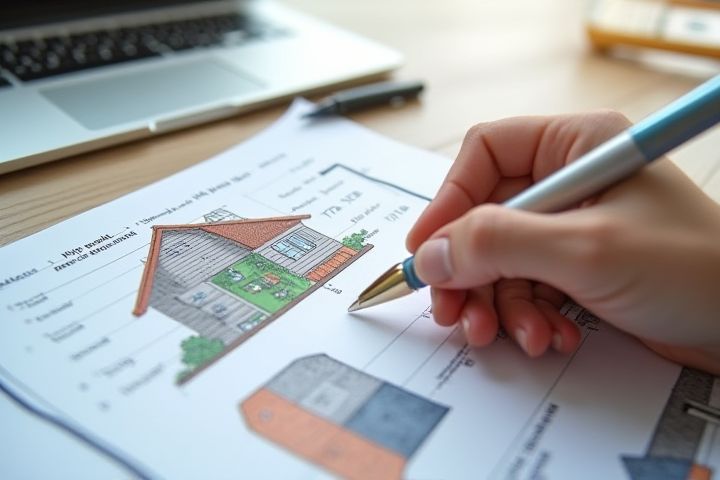
Start by defining your renovation goals, whether it's increasing living space, updating aesthetics, or enhancing energy efficiency. Create a comprehensive budget that includes costs for materials, labor, permits, and unexpected expenses to avoid financial surprises. Research and hire reputable contractors with experience in your specific type of renovation, checking reviews and past projects for credibility. Develop a timeline that outlines each phase of the project, helping you manage expectations and minimize disruption to your daily life. Finally, ensure you obtain all necessary permits and comply with local building codes to proceed with your renovation smoothly and legally.
How To Plan A House Renovation
Set a realistic budget
To effectively plan a house renovation, you should begin by setting a realistic budget that encompasses all aspects of the project. Analyze costs related to materials, labor, and permits, ensuring you account for unexpected expenses that may arise during construction. Research similar renovations in your area to gauge average costs and determine a reasonable range for your budget. By prioritizing essential upgrades and considering DIY options, you can make informed financial decisions that align with your desired home improvements.
Prioritize needs vs. wants
Begin your house renovation by listing your essential needs, such as structural repairs, safety upgrades, and necessary system replacements, which may account for approximately 60-70% of your budget. Next, identify desired upgrades or aesthetic improvements that would enhance your lifestyle but might be more discretionary, like luxury finishes or advanced appliances, which can represent the remaining 30-40% of your spending. Create a checklist of projects ranked by importance, ensuring that critical repairs are tackled first before diverting funds to wants. Finally, set a realistic timeline, aligning your renovation phases with your budget constraints to keep your project manageable and focused on both necessity and desire.
Hire reliable contractors
When planning a house renovation, hiring reliable contractors is crucial for a successful outcome. Research local contractors by checking online reviews, ratings, and their project portfolio to assess their experience and quality of work. Schedule interviews with potential candidates to discuss your vision, budget, and timelines, ensuring they understand your needs. Finally, verify their licenses, insurance, and references to guarantee professionalism and accountability throughout the renovation process.
Obtain necessary permits
Obtaining necessary permits is a crucial step in planning your house renovation, ensuring compliance with local zoning laws, building codes, and safety regulations. Start by researching the specific permits required for your project type, which can often be found on your city or county's building department website. You may need to submit detailed plans and specifications, along with applications, fees, and possibly a timeline for your renovation. Engaging with local contractors or architects can also facilitate the process, as they often have experience navigating the permitting landscape.
Plan for unforeseen expenses
When planning a house renovation, allocate a portion of your budget specifically for unforeseen expenses, typically around 10-20% of your total budget. Research potential issues that could arise in your project, such as outdated plumbing or electrical systems that may require upgrades. Create a detailed timeline that includes milestones, as delays can lead to increased costs, so having a buffer in your budget helps mitigate financial strain. Consulting with professionals, such as architects or contractors, can provide insights into common pitfalls, ensuring you're better prepared for unexpected challenges during the renovation process.
Establish a clear timeline
To establish a clear timeline for your house renovation, start by defining the project's scope and identifying priority areas, such as the kitchen or bathroom. Break the project into distinct phases, allocating specific timeframes for each, such as demolition, construction, and finishing touches. Incorporate buffer periods for unexpected delays, and ensure you set milestones to measure progress and make adjustments as necessary. Regularly review the timeline to stay on track and maintain communication with contractors and tradespeople to ensure everyone is aligned with the schedule.
Choose durable materials
Choosing durable materials is crucial for a successful house renovation, as they can enhance longevity and reduce maintenance costs. Opt for materials like quartz countertops, which are non-porous and resistant to scratching, or hardwood flooring, known for its durability and timeless appeal. Consider using fiber-cement siding for your exterior, as it withstands harsh weather conditions better than traditional wood or vinyl options. Investing in high-quality, sustainable materials may initially require a larger budget, but they pay off over time by reducing the need for repairs and replacements.
Ensure proper ventilation
When planning a house renovation, incorporating proper ventilation is crucial for maintaining air quality and comfort. Start by evaluating your current ventilation system, including windows, exhaust fans, and any mechanical systems in place. Consider installing energy-efficient options like whole-house fans or heat recovery ventilators to enhance airflow while minimizing energy costs. Prioritize the placement of vents and windows in your design to ensure optimal cross-ventilation, reducing humidity and preventing mold growth in your refreshed living spaces.
Focus on energy efficiency
Assess your current energy usage to identify areas where improvements can be made, such as outdated windows or insulation. Invest in energy-efficient windows that feature double or triple glazing to minimize heat loss and reduce your heating bills. Consider installing a programmable thermostat and energy-efficient HVAC systems to optimize your home's heating and cooling. Incorporate sustainable materials and energy-efficient appliances to further enhance your home's overall energy performance and reduce your carbon footprint.
Communicate openly with professionals
Open communication with renovation professionals, such as architects, contractors, and designers, ensures that your vision aligns with their expertise. Schedule regular meetings to discuss project timelines, budgets, and design elements, allowing for transparency and adjustments as needed. Sharing your preferences and concerns clearly can lead to better outcomes, with around 70% of renovation projects benefitting from proactive dialogue. Establishing a collaborative relationship fosters trust and can significantly reduce misunderstandings, ultimately leading to a smoother renovation process.
